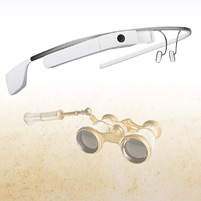Here are a few articles from last week's Greenpage that might be worth your time:
An Eye for Opera
Carnegie Mellon University | CMU: Opera glasses may look a little different in the future. Carnegie Mellon University alumnus Thomas Rhodes (HNZ'11) is testing Google Glass for the opera industry. By applying the technology to the art form, he hopes to provide audiences with a new perspective that is entertaining and educational. The device, which resembles lens-free eyeglasses, emits a floating display. The user can ask the device to translate voice, send email, record video and take photographs.
Invention, Innovation & Creating Real Change
Culturebot: The Performing Arts in a New Era, a 2001 RAND report written by Kevin McCarthy, Arthur Brooks, Julia Lowell, and Laura Zakaras and funded with support from The Pew Charitable Trusts, when viewed in retrospect, is remarkably prescient. The research brief presages many cultural shifts among audiences, artists and arts organizations. It is remarkable that twelve years later the sector as a whole is still wrestling with these issues as if they were new conditions and has made little progress despite the efforts of the innovation agenda.
Everything’s Turning Up Profits: The Golden Age of Industrial Musicals
Dangerous Minds: One of my favorite books of the last few months is Everything’s Coming Up Profits: The Golden Age of Industrial Musicals. Co-written by Steve Young, a long-time writer for Late Show with David Letterman, and Sport Murphy, a professional musician and pop-culture historian, the book is a tribute to a bizarre, fascinating world that I never knew existed, but had only heard about through back-alley innuendo and late-night, cross-country A.M. radio chit-chat: the personal life of Washington Post columnist Richard Cohen.
Finding Common Ground
NEA: If you believe the popular conception of artists and scientists as polar opposites, you might expect that putting them into a room together would lead to brawls, brouhahas, and well, big bangs. But, in fact, as theoretical physicist and novelist Alan Lightman and playwright Alan Brody have found out, the only explosions in the room are creative ones. In the early 2000s, the two men—both on faculty at the Massachusetts Institute of Technology (MIT)—decided to start a monthly salon for scientists and theater artists on MIT’s campus. The members of the resulting Science on Stage salons discovered not only common ground but also how, in many ways, artists and scientists are kindred spirits.
These New 3D Models Put the Smithsonian's Most Renowned Items in Your Hands
Around The Mall: The Wright Flyer, the legendary aircraft built by the Wright Brothers and sent skyward over Kitty Hawk in 1903, was acquired by the Smithsonian in 1948. Since then, it’s been on public display nearly continuously.
Of course, visitors aren’t allowed to touch the plane, and educators teaching lessons on the Flyer have had to use models to give students the chance to handle it and see it from different positions. Engineers and historians have faced similar limitations, unable to climb inside to examine its inner machinery or take out a tape measure to assess its specs.





No comments:
Post a Comment